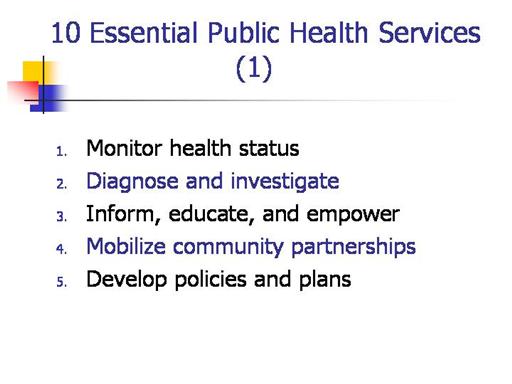| front |1 |2 |3 |4 |5 |6 |7 |8 |9 |10 |11 |12 |13 |14 |15 |16 |17 |18 |19 |20 |review |
 |
1.1.Monitor
Health Status to Identify Community Health Problems
·-
Assessment of state wide
health status and its determinants, including the identification of
health threats and the determination of health service needs
·-
Utilization of
appropriate methods and technology, such as geographic information
systems, to interpret and communicate data to diverse audiences.
2.
Diagnose and Investigate
Health Problems and Health Hazards in the Community
·-
Epidemiological
investigations of disease outbreaks and patterns of infectious and
chronic diseases and injuries, environmental hazards, and other health
threats.
·-
Access to a public
health laboratory capable of conducting rapid screening and high volume
testing.
·-
Population-based
screening, case finding, investigation, and the scientific analysis of
health problems.
3.
Inform, Educate and Empower
People about Health Issues
·-
Health information,
health education, and health promotion activities designed to reduce
health risk and promote better health.
4.
Mobilize Community
Partnerships to Identify and Solve Health Problems
Identifying potential
stakeholders who contribute to or benefit from public health, and
increase their awareness of the value of public health
·-
Assistance to partners
and communities to organize and undertake actions to improve the health
of the state's communities.
5.
Develop Policies and Plans
that Support Individual and Community Health Efforts
•-
Systematic health
planning that relies on appropriate data, develops and tracks measurable
health objectives, and establishes strategies and actions to guide
community health improvement at the state and local levels.
•-
Development of
legislation, codes, rules, regulations, ordinances and other policies to
enable performance of the Essential Public Health Services, supporting
individual, community, and state health efforts.
|